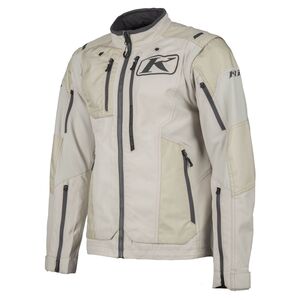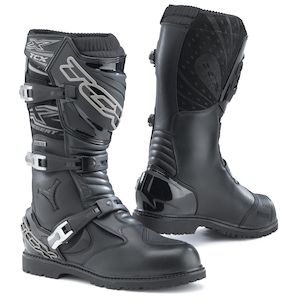Nothing broke, and my ankles didn't hurt. That was one indication there was something very right about this design. Landing 500 pounds and 121 years of motorcycle engineering and development from a height of several feet in the air can make an odd noise, but sometimes that's part of testing.
Southern Spain was the scene as a host of journalists tried out the latest iteration of Triumph's Tiger 900 platform. Diverse terrain — including that one enthusiastic off-road jump described above — and a diverse group of riders provided a wide range of perspective about a motorcycle even more capable than I already thought.
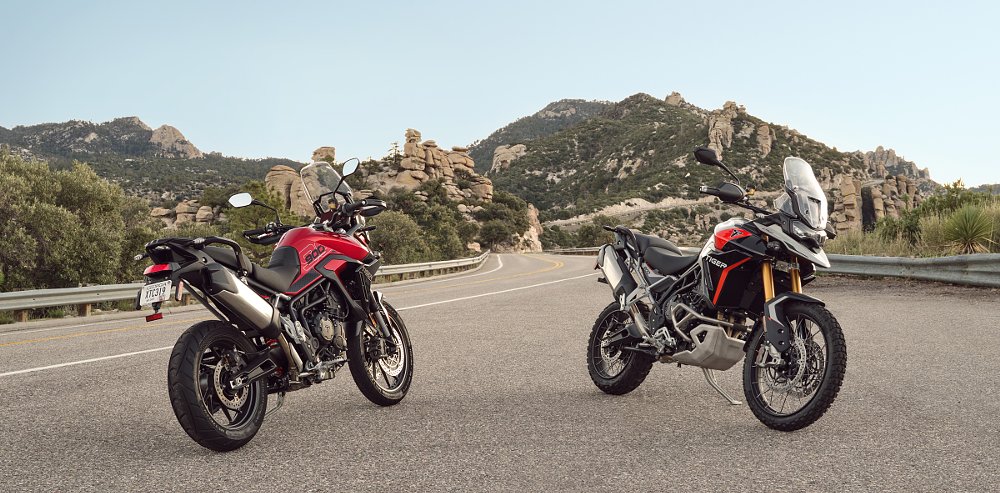
A brief history to set the scene
The adventure motorcycle segment has seen significant change in the diversity of its product offerings in recent years. While displacement one-upsmanship continues at the upper end of the displacement spectrum, roughly 14 years ago a "middleweight" twin-cylinder category emerged and began gaining traction among adventure-traveling enthusiasts. Surprisingly, Triumph entered this fledgling segment with more cylinders, arguably more standard features than any competing bikes, and managed to do so at a comparatively low price point.
In the early 2000s, most heavyweight adventure bikes hovered around 1,000 cc and above. With the exception of BMW's boxer design, most of these bikes sported V-twin engines. Around 2008, things began to change as BMW introduced the F 800 GS, and Triumph introduced the Tiger 800 a couple years later in 2010. Today, parallel-twin bikes dominate this middleweight sector, with the Triumph remaining the outlier by sporting its in-line triple powerplant.
In 2020, the Tiger 800 underwent a significant transformation to become the Tiger 900, and while the mechanical changes for 2024 are mostly impossible to spot visually, the claim that the new model is a “significant update” is well founded.
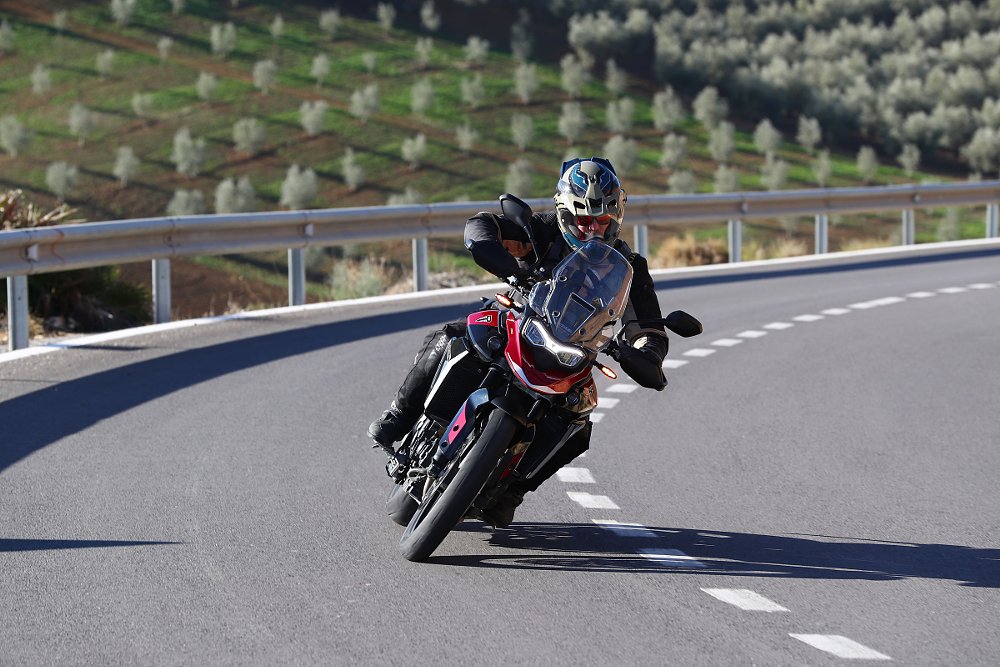
The three-cylinder engine that's an ADV outlier
Triumph's use of a triple-cylinder powerplant is the most obvious thing that sets this bike apart from any other in the middleweight adventure class. Over the years, I've always appreciated the smooth buzz of this engine, both because it's effective and also unique. That said, one characteristic I always missed when riding the triples was the lower-rpm torque offered by twin-cylinder machines (or thumpers, for a more extreme example). For 2024, Triumph's redesign of the Tiger 900 engine now puts the torque lower in the rev range, and this characteristic alone is one of the key things to appreciate about the new bike.
Triumph and BMW are obvious comparisons, with BMW releasing the F 900 GS this year on a parallel track with Triumph and the Tiger 900. Rolling the clock back to the previous iterations of these two bikes and comparing the power delivery characteristics, the Tiger 800 XCa produced its best power around 1,000 rpm higher than the F 850 GS. This resulted in the Triumph needing to be ridden higher in the revs, and lessened the feeling of "hit" on the trail, especially at lower speeds in more technical situations.
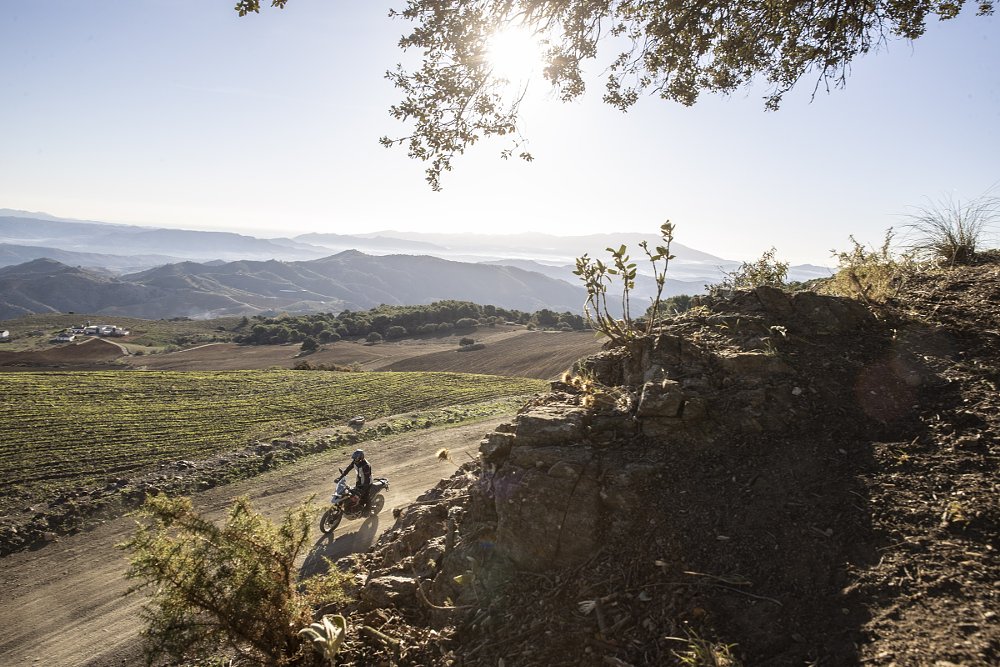
With the 2020 release of the Tiger 900, horsepower and torque numbers rose, but the engine retained some of the higher-revving power delivery character of the previous 800 cc engine. For 2024, new pistons, larger inlet ports, and a more free-flowing Akropovič exhaust (with a slick carbon fiber end cap) have resulted in many changes to the Tiger 900 engine. Compression has increased to 13.0:1 compared to 11.27:1 on the 2023 900, horsepower has gone from 93.9 (70 kW) at 8,750 rpm to 106.5 (79.5 kW) at 9,500 rpm, and the torque now hits lower at 66.4 foot-pounds at 6,850 rpm compared to 64 foot-pounds at 7,250 rpm on the previous model. All these performance gains were achieved without any increase in weight, and the new engine is also claimed to be more efficient and cleaner burning.
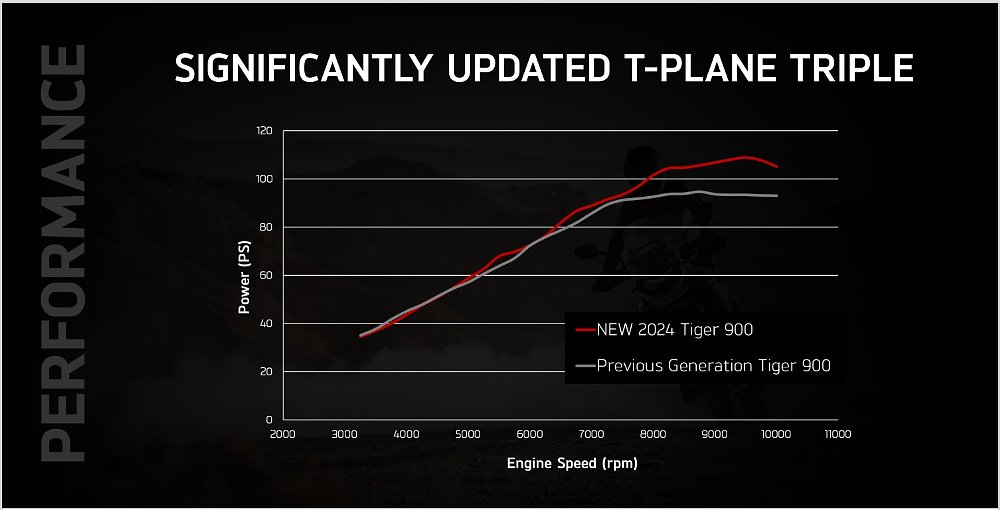
Triumph's T-plane crank design remains the same for 2024 as previous years, and enhances the torquey feel of the engine. The T-plane name comes from the appearance of the crankshaft, when viewed on-end. Inline triples traditionally have the crank pins evenly spaced at 120-degree intervals around the crankshaft. Triumph spaces the pins at 90-degree intervals, forming the shape of a letter T. This design provides the Tiger's characteristic sound, and creates a traction advantage by increasing the power pulse gap through the uneven firing interval.
While the uncommon buzz of a triple takes some getting used to on the trails, the learning curve on the tarmac is much shorter. With almost no perceptible kinks in the torque curve, the Triumph offers up whatever power is desired, in whatever gear, at whatever speed. Those more oriented to off-road riding just have to get used to hearing the scream of a three-cylinder motor moving them along.
For 2024, the Tiger 900 line consists of three models: the GT, the GT Pro, and the Rally Pro.
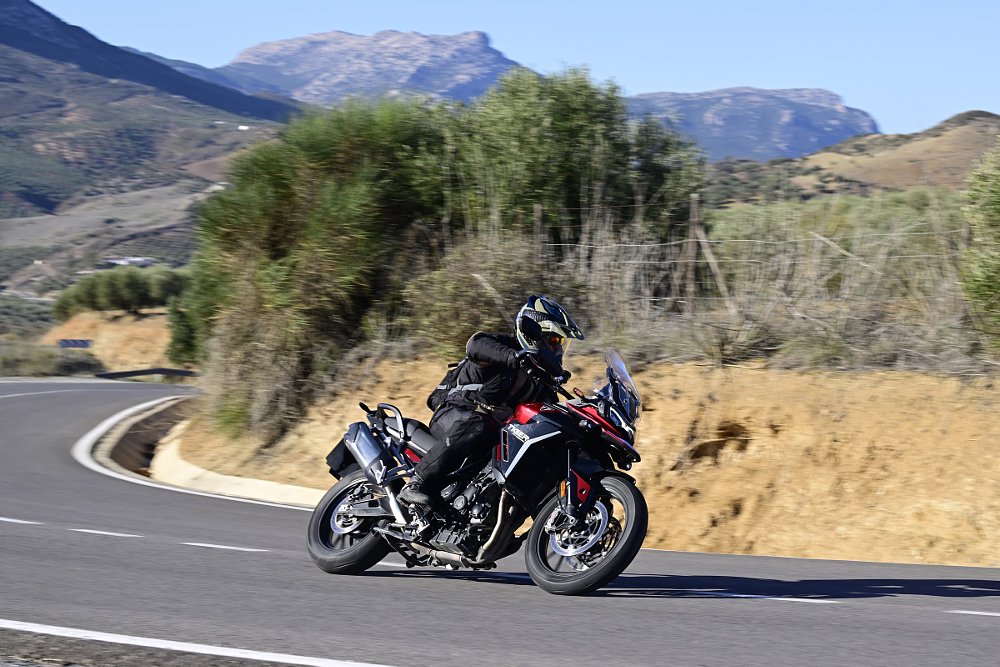
On the road: The Tiger 900 GT Pro
Cast wheels, a lower seat, and shorter suspension are a few of the key elements which place the Tiger 900 GT and GT Pro in the "Urban Adventure" category. The Pro in GT Pro gets you an additional customizable rider mode, a quickshifter (known as "Triumph Shift Assist"), LED auxiliary lights, heated pilot and passenger seats, heated grips, a center stand, a tire pressure monitoring system, and electronically adjustable rear suspension. With the exception of the additional rider mode and the electronically adjustable rear suspension, all of these features are also available as individual options on the standard GT model. Both bikes also now sport the same seven-inch TFT display found on the larger Tiger 1200.
Leaving the Higuerón Hotel Málaga, our group was almost immediately thrown into some extremely twisty pavement curves. I was thankful to begin this test on the road, in that the more empirical environment of pavement can reveal some nuances in handling characteristics that can be more difficult to perceive off-road.
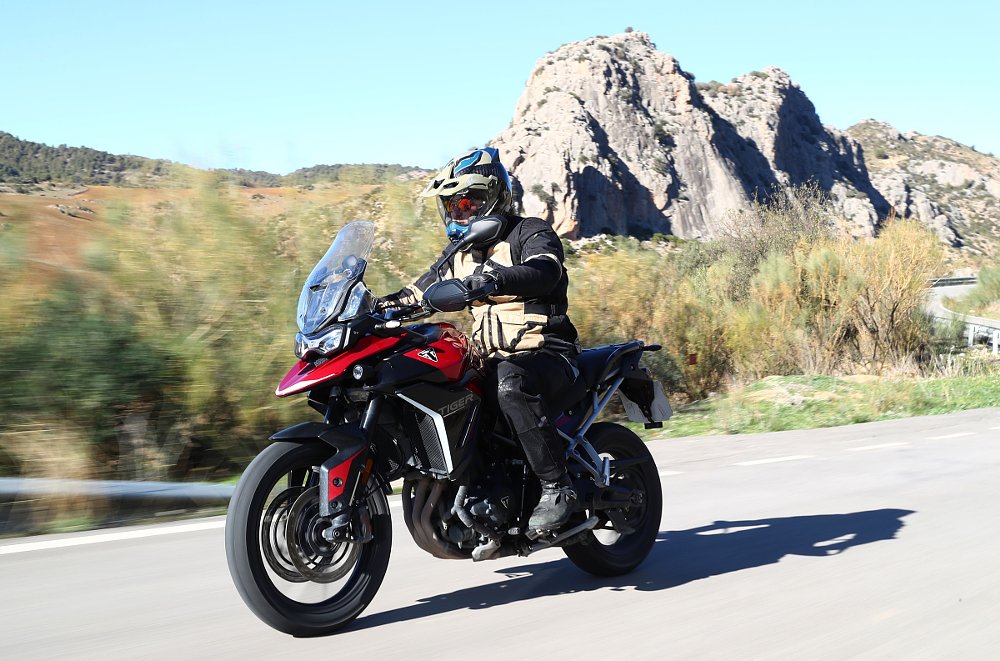
The familiar eagerness of the triple engine on the pavement was a welcome beginning to the ride. Changes in the power delivery of the engine were immediately noticeable, particularly when accelerating out of corners. I could feel more low-end grunt pulling harder, where in the past I might have felt the need to grab a gear at the same rpm. When I did need to grab a gear, whether up or down, the quickshifter was nearly foolproof. Botch a shift hard enough and the Shift Assist will hesitate, of course, but otherwise, the feature always rewarded riding in a reasonably competent manner. When riding off-road, this feature can be disabled, which helps prevent accidental shifts should a toe nudge the shifter when the going gets rough.
For my five-foot, 11-inch frame, the cockpit felt ideal. An easily adjustable windscreen can be repositioned with one hand while riding, however, I preferred to keep it in the lowest position at all times. Higher windscreen positions created a nice, silent bubble of calm air, but the screen itself interfered with the field of vision when raised. No buffeting was experienced in the lowest position, so I always opted for smooth and direct airflow, and a clear and open view of the road.
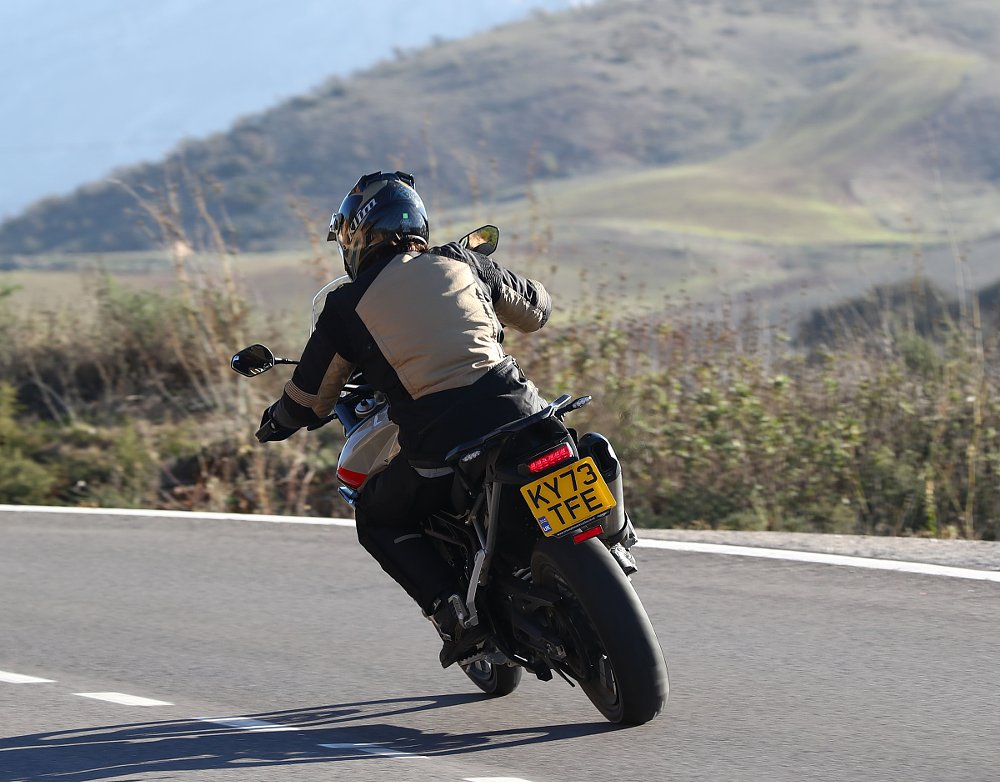
We only rode the GT Pro during the road portion of this event, and that turned out to be instructive, because of the electronically adjustable Marzocchi rear suspension. The first several miles of the test were a perfect mix of tight curves, super-tight curves, pristine pavement, average pavement, sketchy pavement, and in many cases, completely missing pavement. During these first few miles, the bike honestly felt weird, and I would later learn it was because I didn't go through the suspension settings before taking off.
Between the updated engine and Brembo Stylema brakes, straight-line acceleration and deceleration were fun and confident. When cornering, the bike often felt like it "fell" into corners, and oddly reminded me of the (older single-cylinder) BMW G 650 GS or earlier KTM LC4e bikes, and the front would occasionally push through corners. At first, I chalked it up to the possibility of cold tires (it was 39 degrees Fahrenheit when we left, and remained cold most of the day), pavement conditions, or simply me not being used to the bike.
At the first break stop, I was chatting with Triumph Chief Engineer Stuart Wood about navigating the modes on the TFT, and that's when it was discovered the preload was dialed in for two people plus luggage. In theory, that should help with sharper turning by steepening up the head angle, but resetting the bike for a single rider made a huge difference for the better in overall handling. Of note, I was told the suspension settings are based on an assumed rider weight of around 80 kilos (176 pounds). At 185 pounds, I'm in the ballpark of this standard, and the settings seemed to agree.
Two extremely welcome features revealed themselves based on the cold temperatures — the heated grips and heated seat(s). Both are activated via independent, dedicated buttons, versus a menu on the TFT. When you're cold and don't want to be, the last thing you want to be doing is navigating around a menu. The pilot's heated seat is controlled by a switch on the left-side cluster, while the passenger has a dedicated switch on the pillion seat. The fact that Triumph is the only manufacturer I can think of to put the heated grip switch on the actual handgrip for this class of bike baffles me. It's so logical. For those who primarily ride off-road, this switch arrangement might have a downside as replacing the grips could likely get expensive when they wear out.
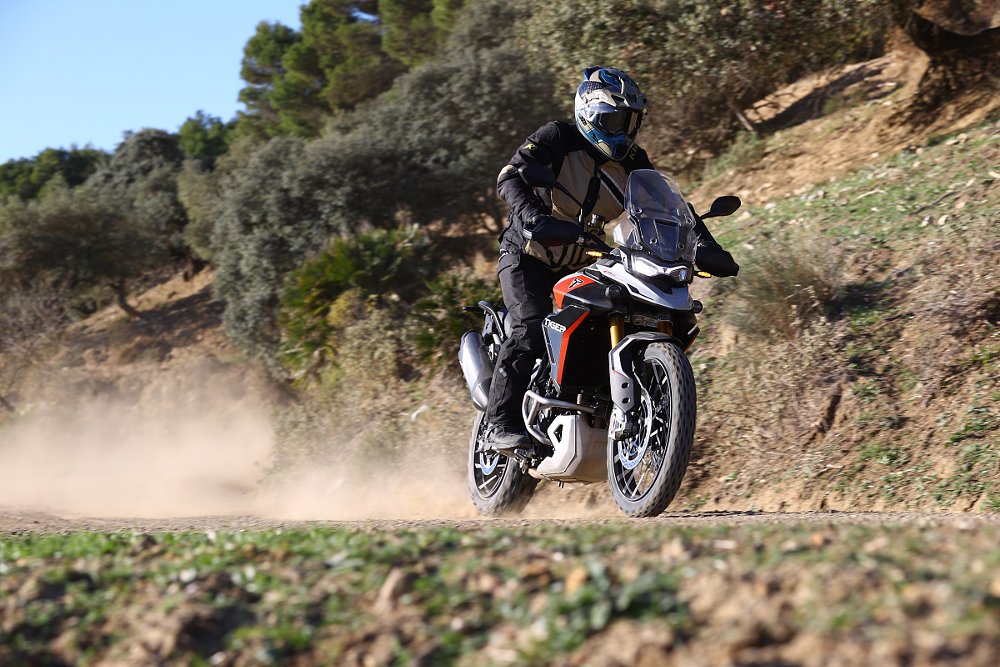
Off-road: The Tiger 900 Rally Pro
In addition to all the features of the GT Pro listed earlier, the Rally Pro adds wire spoked tubeless wheels, crash bars, an aluminum skidplate, and replaces the GT Pro's Marzocchi suspension with manually adjustable Showa suspension with a longer travel of 9.4 inches (240 mm) front and 9.1 inches (230 mm) rear.
Most of the off-road route for this event was moderately smooth gravel roads, with bits of deeper sand in some churned-up corners, and a few stretches of hard-packed, cross-rutted rocky roads. Through all this, the suspension stood out as being very confidence-inspiring, tipping towards the firm side of the scale.
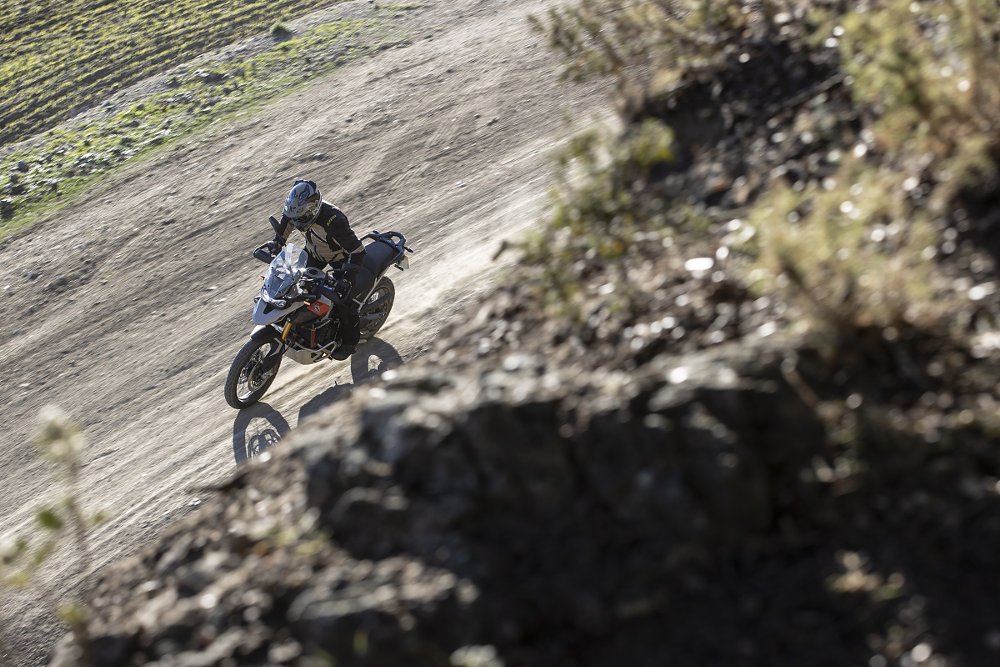
While not harsh, on some of the rougher hardpack roads, feedback through the hand grips was firm and pronounced through the initial part of the stroke. In the moderate off-road conditions, I never found the limits of either the fork or shock travel — until the end of the day.
To conclude our off-road experience, we were guided to Triumph's training facility in the Montes de Málaga mountain range to play around in a proper off-road course. Jumps, hillclimbs, descents, large flat areas, and narrow single-track trails are strewn about this moderately sized moto park. Pro Triumph rider Iván Cervantes was on site to run a few psycho laps around the place, demonstrating beyond any doubt what the Triumph Tiger 900 Rally Pro is capable of.
Seeing pro riders do their thing is inspiring, and opens your mind to possibilities that might not otherwise be there. Case in point, after one 90-degree left turn, there was a gentle hill climb which, if done fast enough, could turn into a jump. The welcome torque of the redesigned 900 engine meant you could easily make the sharp turn in first gear, quickly click up to second without much speed, and let the torque of the motor pull the bike up and over the hill. So that's what I decided to do.
Sport is the most aggressive throttle map, but even in the slightly less aggressive Road setting, a quick blip of the throttle confidently flung the bike up this hill, past the crest, and according to one witness, over five feet into the air. By all reports the landing made a hell of a noise, and I definitely felt the bump stops in the suspension. Surprising takeaways included the accurate and positive feel of the throttle, balance of the bike both on the ground and in the air, and that I've had harder landings on other bikes from much lower heights.
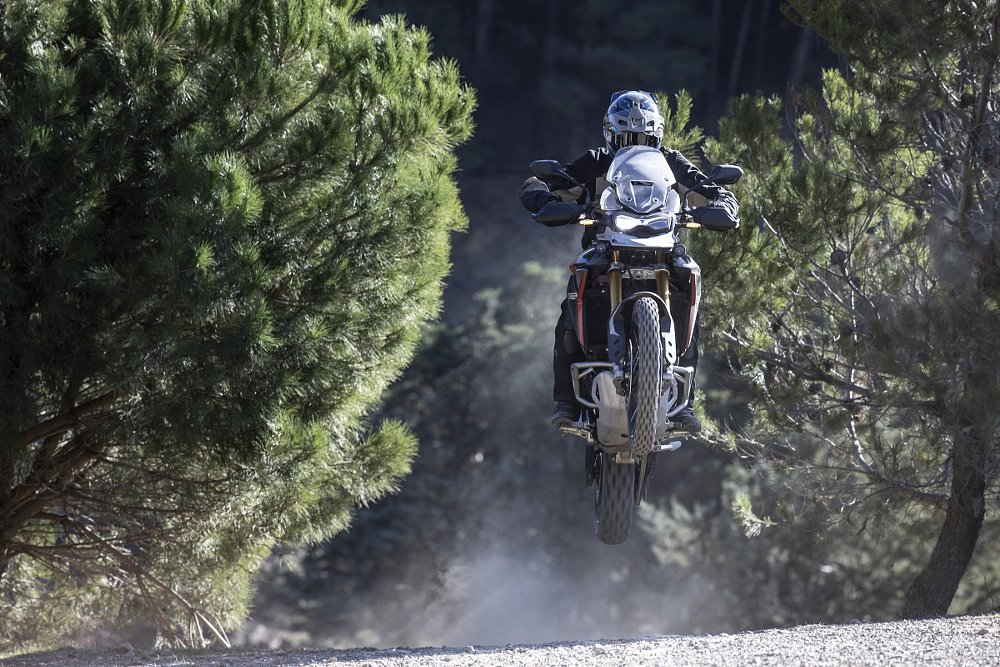
Absent was the impact feel through the wrists and ankles that can come with bringing an adventure bike in for re-entry like this. The Tiger hit bottom and rolled away clean. Subsequent runs on this same hill and jump explored reduced heights more likely within the limits of what the springs and frame were designed to absorb.
Between impressive Showa suspension, an engine that's simultaneously torquey but with a strong top end, a chassis with what feels like excellent flex characteristics, and simple things like decently sized stock footpegs, the Rally Pro is a bike that begs you to test your limits, because you'll find them long before the bike reaches its limit. This isn't hyperbole. In 2022, Cervantes took first place in the Trail category of Spain's Baja Aragón Rally on a completely stock Tiger 900 Rally Pro… over one hour ahead of the number-two rider.
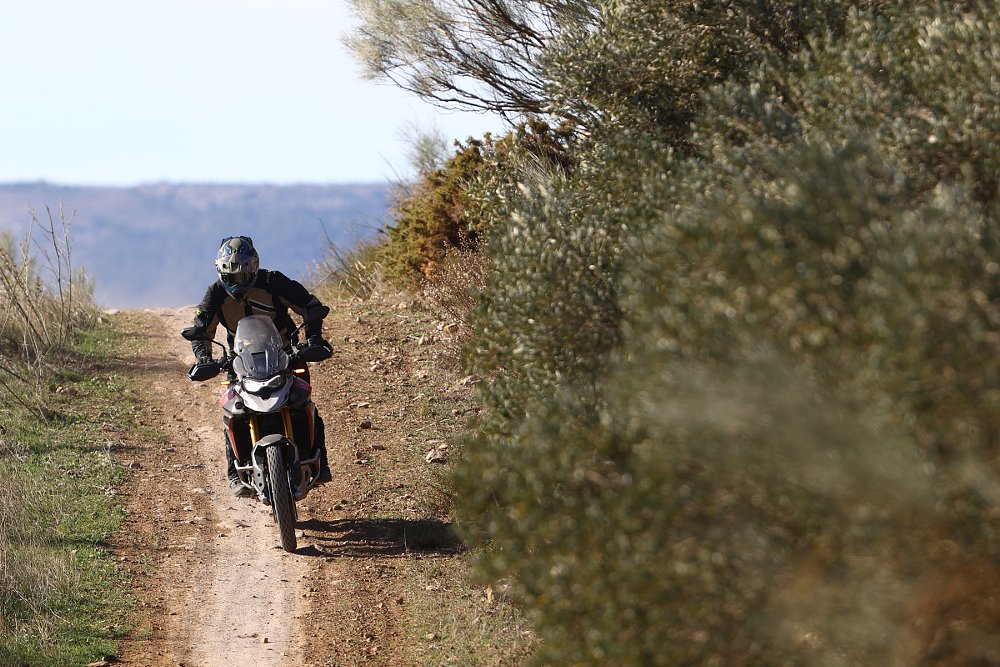
TFT: Clock time is different from lived time
Moore's Law sounds like something that would more readily applied to electric motorcycles than anything internal combustion, but the pace of technological progress is a veneer wrapped around nearly everything in the modern era, and motorcycles are no different. TFT displays are a relatively recent addition to motorcycles, and now bikes are mimicking characteristics of the "device" era. Menus become an integral component of the riding experience. While it's an interesting challenge to determine a best practice for the user interface arrangement of feature selection, the concept can perhaps be distilled down to time, and the number of button-pushing steps.
Knocking out a few hours on the trail can feel like it's over all too quickly, while waiting for the second hand to complete its path around a wristwatch can feel like an eternity. How we experience time depends on the experience that time is monitoring. For example, 20 seconds does not sound like a large commitment out of one's life, but when that same 20 seconds is spent waiting for the TFT on a Honda Africa Twin to come to life, time feels like it moves as quickly as a line at the Department of Motor Vehicles.
Where the latest Africa Twin is arguably at the extreme end of motorcycle interface intricacy, Triumph's digital interface on the Tiger 900 models would fit somewhere in the middle of the pack, as far as complexity, edging a bit towards the more complex and refined side of things. Increased complexity seems to come at the expense of UI speed, and while the Tiger's display does not require 20 seconds to boot up, more than once I found myself hitting the starter button two or even three times before realizing I just had to wait that eternity of 1.x seconds before the electrons made the trek from the button, through the ignition systems, and looped back.
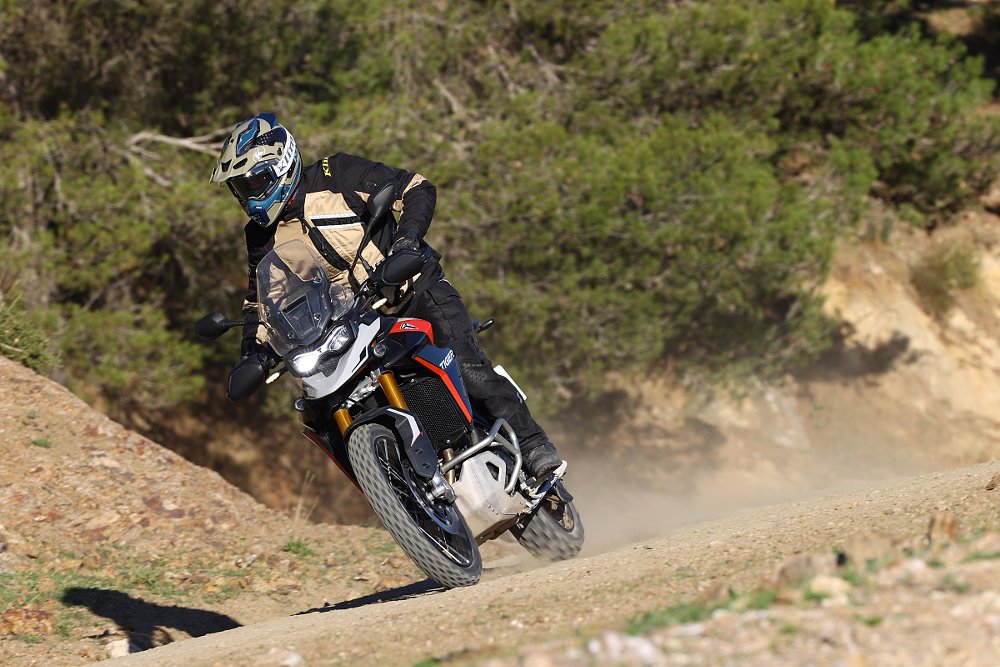
The 900 Rally Pro comes with six riding modes: Rain, Road, Sport, Off Road, Rider, and Off-Road Pro. The first four are preset modes, "Rider" is a dedicated customizable mode, and Off-Road Pro is an easy way to get the bike quickly set up for those of us who prefer the least computer intervention possible. Thanks in part to regulations, the modes we use most as off-road riders are intentionally more difficult to access. Virtually every adventure bike currently available will reset the "fun" modes to something considered "safe" any time the bike is power cycled. Each manufacturer has its own take on how to navigate the systems upon power up, and Triumph added a new twist by circumventing the menu dance with a unique mode recall function.
When riding this highly modern bike in the raw and gloriously old-school Off Road Pro mode, turning the key off will result in the bike re-setting itself to the nanny-compliant Road mode. However, when powered up again, a message appears on the TFT asking if you'd like to recall the most recently used mode. A tick of the mode button, a second tick of the selector switch, and you're back to whatever your previous mode selection was. In my case, this was Off Road Pro for virtually the entire day. Of course, simply leaving the key on and using the kill switch to save the settings is becoming the more common way to manage most TFTs during a day's ride, but the mode recall option is a very welcome feature on the Triumph for when the bike is powered off during longer rides.
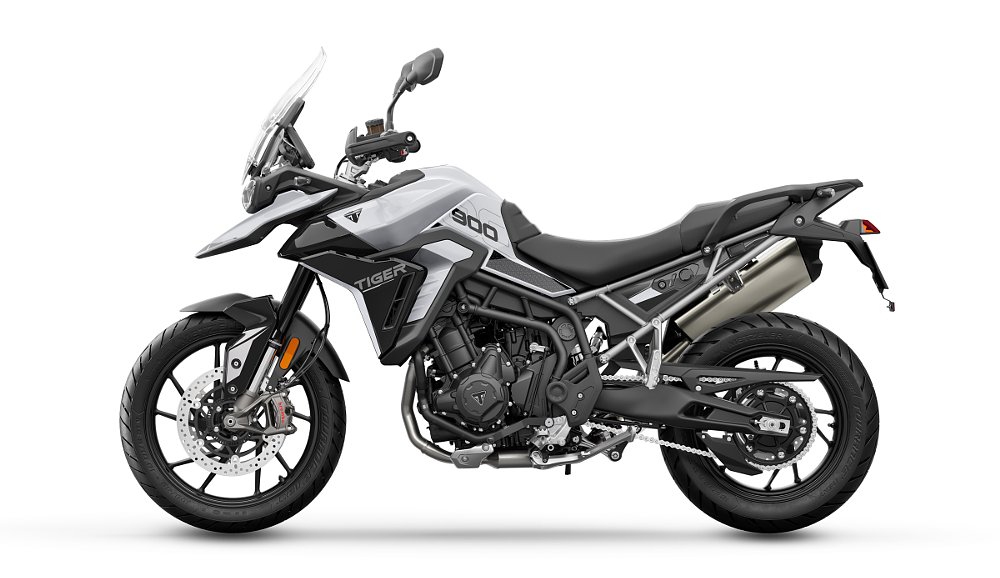
Final thoughts on the new Tiger 900s
Triumph's presentation of the new Tiger 900 models underscored one of my favorite things that can happen during motorcycle intros — being surprised by a new bike. Sure, the bike was plenty familiar, but that familiarity resulted in a greater appreciation of how this platform has been updated.
I once described the elegant curves in the Tiger's frame as looking like something Ducati might have designed. An entirely unique power plant, housed in an artistic and high-performing chassis, and controlled by a cutting-edge suite of electronics results in a package that's hard to beat. Don't take my word for it. Ask any of the other people who were competing in the Aragón Rally.
| 2024 Triumph Tiger 900 GT | 2024 Triumph Tiger 900 GT Pro | 2024 Triumph Tiger 900 Rally Pro | |
|---|---|---|---|
| Price (MSRP) | $14,995 | $16,895 | $17,395 |
| Engine | 888 cc, liquid-cooled, 12-valve, inline three-cylinder | ||
|
Transmission, final drive |
Six-speed, chain | ||
| Claimed horsepower | 106.5 @ 9,500 rpm | ||
| Claimed torque | 66 foot-pounds @ 6,850 rpm | ||
| Frame | Tubular steel trellis, bolt-on aluminum subframe | ||
| Front suspension | Marzocchi 45 mm inverted fork, adjustable for rebound and compression damping; 7.1 inches (180 mm) of travel | Showa 45 mm inverted fork, adjustable for preload, rebound and compression damping; 9.4 inches (240 mm) of travel | |
| Rear suspension | Marzocchi shock, manually adjustable for preload, rebound and compression damping; 6.7 inches (170 mm) of travel | Marzocchi shock, electronically adjustable for preload, rebound and compression damping; 6.7 inches (170 mm) of travel | Showa shock, manually adjustable for preload and rebound damping; 9.1 inches (230 mm) of travel |
| Front brake | Dual Brembo Sylema Monobloc four-piston calipers, 320 mm discs with ABS | ||
| Rear brake | Single-piston caliper, 255 mm disc with ABS | ||
| Rake, trail | 24.6 degrees, NA | 24.4 degrees, NA | |
| Wheelbase | 61.3 inches (1,556 mm) | 61.1 inches (1,551 mm) | |
| Seat height | 32.3 to 33.1 inches (820 to 840 mm) | 33.9 to 34.6 inches (860 to 880 mm) | |
| Fuel capacity | 5.3 gallons (20 liters) | ||
| Tires | Metzeler Tourance Next, 100/90-19 front, 150/70R17 rear | Bridgestone Battlax Adventure 90/90-21 front, 150/70R17 rear | |
| Claimed weight | 483 pounds (219 kg) wet | 489 pounds (222 kg) wet | 503 pounds (228 kg) wet |
| Available | Early 2024 | ||
| Warranty | 24 months | ||
| More info | triumphmotorcycles.com | ||

 Membership
Membership









